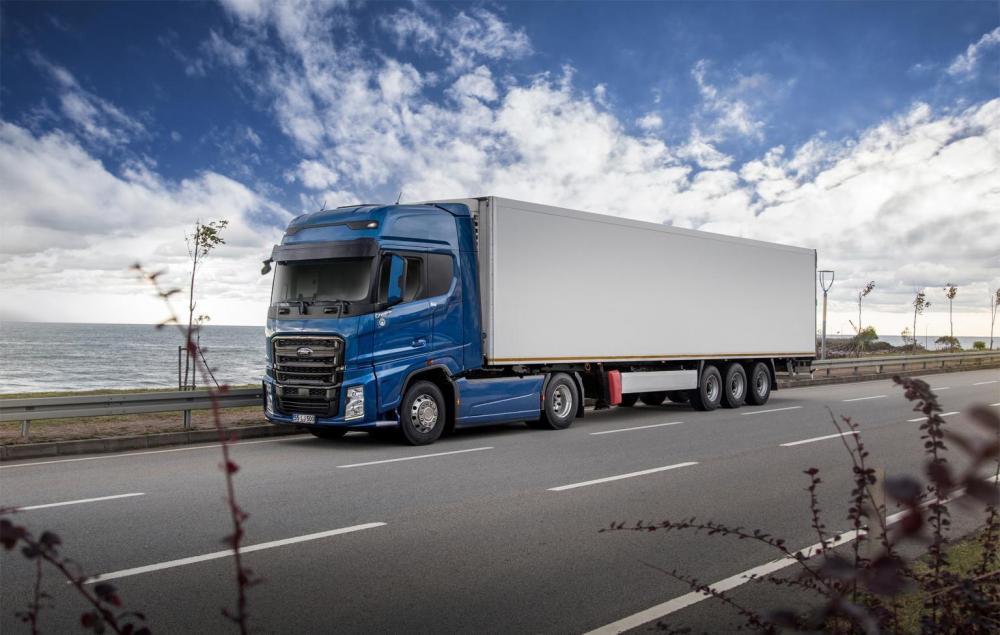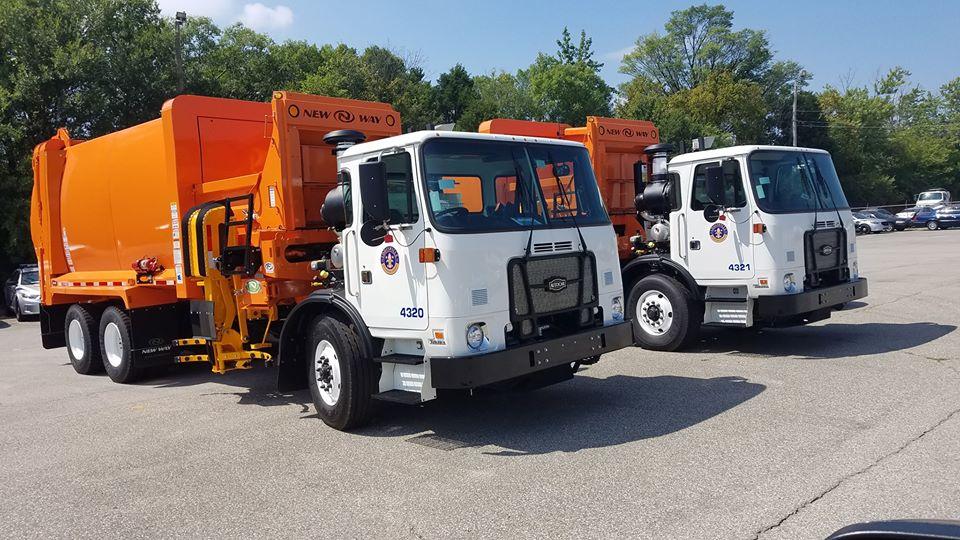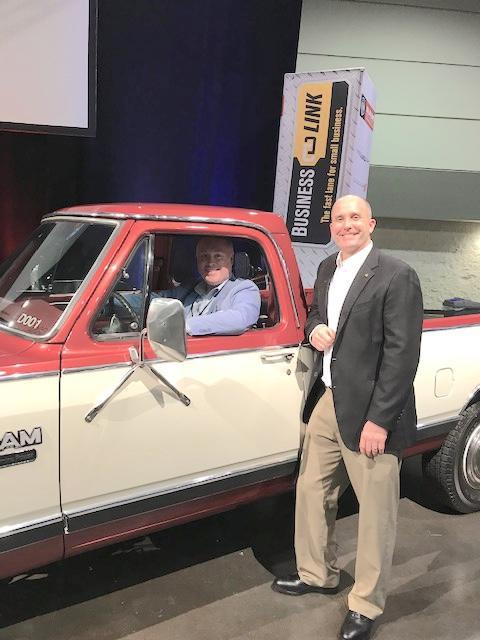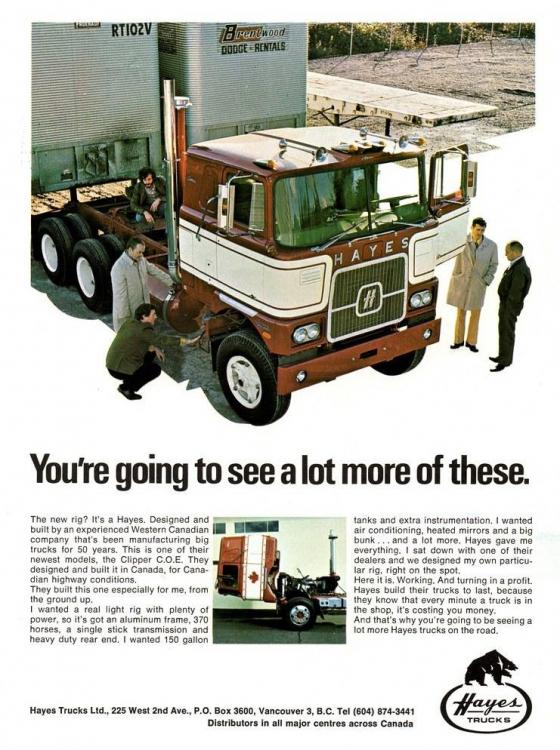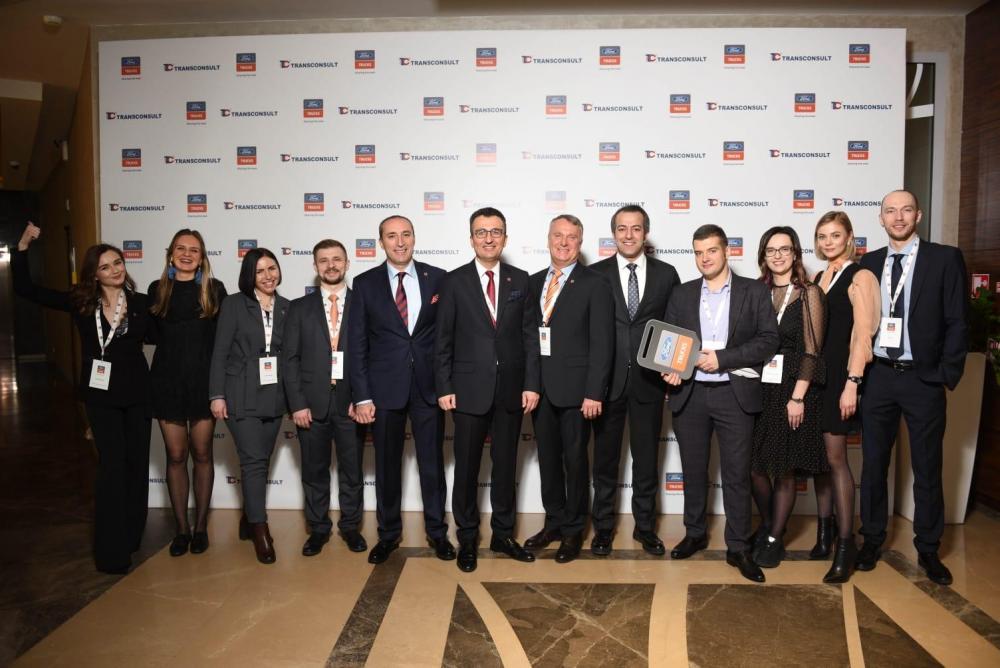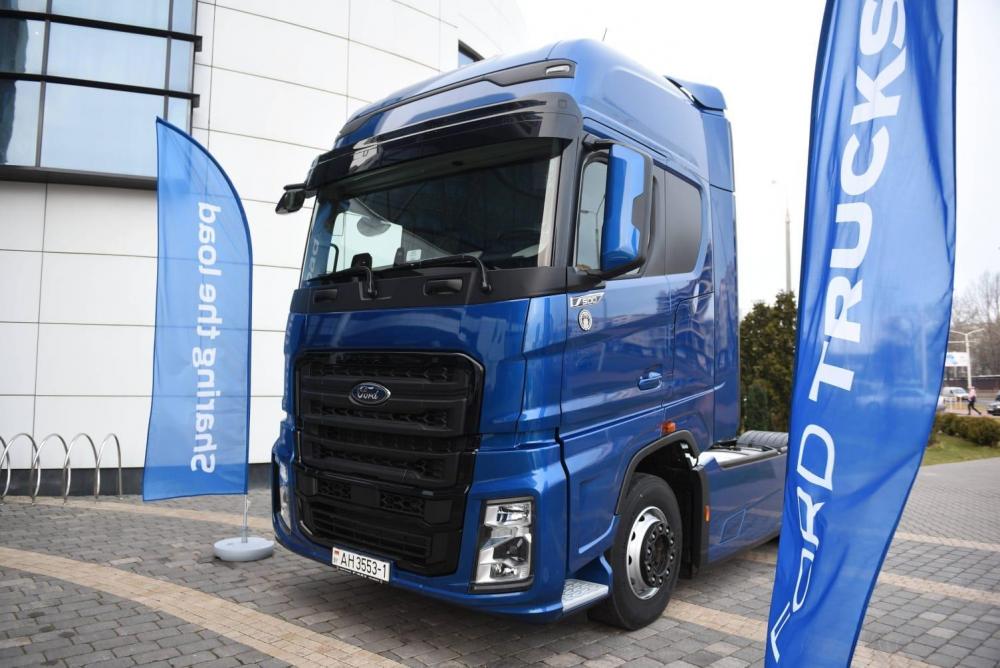
kscarbel2
Moderator-
Posts
18,539 -
Joined
-
Days Won
112
Content Type
Profiles
Forums
Gallery
Events
Blogs
BMT Wiki
Collections
Store
Everything posted by kscarbel2
-
Dana highlights electric powertrain, new partnerships at ACT Expo
kscarbel2 replied to kscarbel2's topic in Trucking News
Spicer Medium-Duty e-Axles Enter Production Heavy Duty Trucking (HDT) / February 24, 2020 Dana has begun production of its Spicer Electrified eS9000r e-Axle for Class 4 and Class 5 trucks. The e-Axle will be available for ordering by vehicle manufacturers in the third quarter of 2020, the company announced during a Feb. 23 briefing at the annual meeting of the Technology & Maintenance Council in Atlanta. The manufacturer said it is the first to market with this e-Axle classification in North America and is the only supplier with the in-house capability to manufacture all components of the system, including the gears, axle, motor, and inverter. The e-S9000r is based on the Spicer S110, S111, and S130 rear drive-axle platforms engineered for medium-duty truck and bus applications. The eS9000r is engineered as a fully integrated e-Axle, including a gearbox and motor, and is easily incorporated into most existing chassis. Dana said moving the motor to the axle reduces driveline complexity while allowing batteries to be located between the frame rails to simplify truck body positioning. The power rating for the eS9000r is 237 kilowatts or about 317 horsepower at 650 volts DC for grade startability of 20%. The axle has a patent-pending electronically controlled parking pawl system that eliminates the need for an external solution on vehicles without a traditional transmission. The weight of the axle assembly including the water glycol-cooled Dana TM4 SUMO LD motor, CO150 inverter, and disc brakes is 815 pounds. “The electrical componentry replaces the existing axle, driveshaft, transmission and engine, and aftertreatment in a traditional chassis," said Dana Director of Product Planning Steve Slesinski. "This gives our OEM partners some options to put the battery packs either between the frame rails or outside the frame rails." "The eS9000r e-Axle is built on our distinguished single drive axle and e-Powertrain platform, offering a streamlined electronic propulsion system for increased reliability and efficiency," said Mark Wallace, president of Dana Commercial Vehicle Drive and Motion Systems. "With an extensive level of electrification activity in Class 4 and Class 5 vehicles, we anticipate this truck class to be the first for widespread deployment and are ready to support our customers with industry-leading electrodynamic solutions," he added. -
Jacobs Partners with Tula on Cylinder Deactivation for Diesel Engines
kscarbel2 replied to kscarbel2's topic in Trucking News
Jacobs Says Cylinder Deactivation Saves Fuel, Reduces NOx Jim Park, Heavy Duty Trucking (HDT) / February 26, 2020 Jacobs Vehicle Systems has completed testing to quantify the fuel savings and emissions benefits of Jacobs’ Cylinder Deactivation (CDA) technology. Test results showed that CDA reduced fuel consumption by 5% over the baseline in the Hot Federal Test Procedure cycle while increasing exhaust temperatures and limiting the cool-down of the selective catalytic reduction emissions system. Testing was conducted by an internationally known third-party laboratory and funded by the Environmental Protection Agency on a 13L Navistar engine equipped with CDA. The announcement was made in Atlanta during the Annual Meeting of the American Trucking Associations' Technology & Maintenance Council. CDA reduces NOx output by creating higher exhaust temperatures in the operating cylinders for optimal SCR operation. High temperatures necessary for optimal aftertreatment performance are maintained even when the engine is in low-load operation. With three cylinders of a six-cylinder engine deactivated, high exhaust gas temperatures can be maintained in the three operating cylinders. CDA also enables faster warm-up of the aftertreatment system after engine startup and minimizes cooling of aftertreatment substrate during coasting. To demonstrate the capability of the CDA system, the proposed California Air Resources Board "Low Load" cycle was evaluated, and CDA was found to raise the exhaust temperatures by about 50 degrees C, reducing tail-pipe NOx emissions by 86%. Fuel consumption (and CO2) was reduced by 12%. SCR NOx conversion increased from 48% (baseline) to 95% (CDA). Laboratory tests focused on the extent to which Jacobs’ CDA reduces NOx emissions during the low-load cycles representative of real-world driving conditions such as cold startups and frequent low-load and idle conditions that typically cause the most pollution due to a cool aftertreatment system. Testing also sought to quantify CO2 improvements at the same time. CDA is already proven to increase fuel economy and reduce tailpipe emissions in heavy-duty diesel engines, but Jacobs said it welcomed the opportunity to have these benefits independently measured. More extensive tests and results will be published under a joint paper at the April 2020 SAE World Congress. In November 2018, the EPA announced the need for additional nitrogen oxide (NOx) reductions in its Cleaner Trucks Initiative. This is especially important in areas of the U.S. with elevated levels of air pollution, a focus in California for the same reasons. Current heavy-duty truck rules for NOx, adopted in 2010, are expected to be replaced by new rules in the future. Jacobs introduced CDA technology last year in a new application of proprietary components originally designed for the company’s High Power Density engine brake. HPD employs mechanisms in the valve train to disable the opening of the intake and exhaust valves. Jacobs is now involved in numerous CDA development and demonstration projects on commercial vehicle powertrains around the world. -
Dana takes top stake in heavy-duty hybrid systems designer Hyliion
kscarbel2 replied to kscarbel2's topic in Trucking News
Hyliion Delivers First Class 8 Hybrid Vehicles to Penske Heavy Duty Trucking (HDT) / February 26, 2020 Hyliion will provide three vehicles to Penske Truck Leasing equipped with its 6X4HE Class 8 hybrid system, using Spicer Electrified e-Powertrain components. The first of the program’s three vehicles were displayed in the Dana booth at the Technology & Maintenance Council’s annual meeting in Atlanta.The remaining vehicles will be delivered throughout the year, allowing Penske to complement its fleet with the combined Hyliion-Dana Class 8 electrified solution. .“Our hybrid electric system on their Class 8 sleeper truck will reduce fuel consumption while also improving the driver experience,” said Thomas Healy, CEO of Hyliion. “Our collaboration with Dana provided the opportunity to leverage its strong product development process and affiliation with leading fleets such as Penske to help foster this cooperative sustainability program for all key stakeholders.” The Hyliion 6X4HE Class 8 hybrid is full 6x4 configuration with traction boosting capability to improve fuel economy when climbing hills, and 7 kW/hr battery pack that can provide up to 10 hours of hoteling capability. "The hybrid arrangement allows fleets to take advantage of electrified powertrains right away rather than waiting for the grid to be fully built up and large-capacity charging stations installed around the country," says Steve Slesinski, Dana's director of Product Planning. "It does not require any plug in at all, in fact it uses regenerated energy from downhill coasting and regenerative braking." The Hyliion 6X4HE system is available for immediate ordering. -
Volvo offers ZF "ReAX" steering on Mack Anthem
kscarbel2 replied to kscarbel2's topic in Trucking News
-
Fleet Owner / February 26, 2020 ATLANTA — By adding an electric motor to the hydraulic steering column, Volvo can reduce driver effort of turning the wheel by up to 85%, the OEM said at the Technology & Maintenance Council annual meeting. The new option for Volvo's Mack Anthem, called Command Steer, will be available in June. (The ReAX electronic steering system, designed and produced by Germany's ZF, was first introduced in April 2013 as "Volvo Dynamic Steering". Volvo's promotion gave the impression that it was Volvo technology, however it was actually developed by Germany's ZF. Under their agreement, Volvo was the exclusive user for the first 5 years. That time now having expired, ZF is free to sell the system to all truckmakers. ) The motorized component collects driver, vehicle and environmental data and judges what amount of torque to apply to the steering column to ensure the truck stays true to its intended path. The wheel could be turned with one hand exerting the same energy as a kitten lightly swatting butterfly, as opposed to a bulldog-like bite. “Even with the all-day comfort provided by the Mack Anthem model’s ergonomic interior, driving a heavy-duty truck remains a highly physical task,” said Stu Russoli, Mack's highway product manager. “With Mack Command Steer, we’re helping reduce driver fatigue and muscle strain by up to 30%, improving safety and productivity as well as helping to protect the truck’s most valuable asset: the driver.” The new driver-assist solution also comprises a suite of sensors that collect road condition data such as speed and torque on the steering column. This flow of 2,000 pieces of data per second informs the wheel on how to react given the conditions. Drivers fortified by Command Steer “no longer have to ‘fight the wheel’ while driving on poor roads or in difficult weather conditions,” Russoli said. For example, when force generated by high winds unbalances the vehicle and load and causes drifting, Command Steer “will adjust so you could drive very comfortably,” he said. The wheel was also designed to intuitively compensate for unexpected variables on the road. “If you're if you're on uneven ground, your right wheel goes off the road, it's not going to pull you to the side off into a ditch,” Russoli explained. “If you have a flat tire, potholes, other disturbances in the road, it's going to correct that.” The wheel also returns to zero if the driver lets go when backing up to park or going forward to make a turn, beneficial in tight places. NASCAR hauler driver Tony Fripp said “it’s pretty much effortless” as he used one finger to steer the in-reverse tractor-trailer between two other Black Anthem trucks in a video Russoli presented. Mack also said the Anthem day cab models are SmartWay certified by the U.S. Environmental Protection Agency (EPA). To become SmartWay-certified, trucks must have technologies and features that reduce their environmental impact through improved fuel efficiency. “Even with steady diesel prices, customers are continuing to place a strong emphasis on improving the fuel efficiency of their heavy-duty trucks,” said Russoli. “We’re proud to have our Anthem day cab model join our Anthem standup sleeper model as SmartWay-certified, giving customers fuel-efficient options for nearly every over-the-road application.” To achieve SmartWay certification, Anthem day cab models must be spec’d with roof fairings and side shields, chassis fairings and an aerodynamic bumper option. In addition, low rolling resistance SmartWay-certified tires are required. All SmartWay-certified MackAnthem models feature a SmartWay logo on the doorjamb. Just prior to TMC, Mack announced the launch of driver-activated Mack Over The Air updates, enabling customers to activate their software updates on their own schedule. Mack Over The Air allows remote software updates and the setting of vehicle parameters through GuardDog Connect. Available beginning in the fourth quarter, the new driver-activated updates eliminate the need for coordination phone calls with Mack OneCall agents, meaning most updates can be completed in less than 15 minutes.
-
Thousands of truck and trailer assets from defunct Celadon head to Ritchie Bros. auction Tom Quimby, Commercial Carrier Journal (CCJ) / February 24, 2020 Their list has more than doubled in two days. This week, Ritchie Bros. will begin auctioning off truck equipment from defunct Celadon Group (No. 41 in the CCJ Top 250), which closed its doors in December after filing for Chapter 11 bankruptcy. Since announcing the liquidation last week, Ritchie Bros. has been busy adding Celadon trucks and trailers on its website, which quickly grew from 487 items on Wednesday to 1,048 items by late Friday. The current line-up includes model year 2015-2018 tractors. Zac Dalton, Ritchie Bros. director of finance, said he anticipates most of this equipment will be sold through Ritchie Bros.’ unreserved public auctions in the United States and Canada next month. “All items sold at public auction will be sold without any minimum bids or reserve prices,” he said. More information about what assets will be selling where will be available in the coming weeks on Ritchie Bros. website, he says. Celadon equipment will begin selling Wednesday, Feb. 26 at Ritchie Bros.’ Phoenix auction. Other auctions will follow in Denver, Colo. on Mar. 4; Fort Worth, Texas on Mar. 10; Las Vegas, Nev. on Mar. 12; Columbus, Ohio on Mar. 17; Sacramento, Calif. on Mar. 18; Chicago, Ill. on Mar. 19; Chehalis, Wash., on Mar. 26; Nashville, Tenn. on Mar. 20; North East, MD on Mar. 24 and Atlanta, Ga. on Mar. 27. Prospective buyers can begin online bidding now through the company’s new PriorityBid service. Similar to bidding online through eBay, competitive bids will be made at preset increments. Customers can increase their PriorityBid if it is surpassed by another bid during the auction. PriorityBidders automatically win tying bids. “We’ve always been able to accommodate customers who want to place bids that can’t be there,” said Jake Lawson, senior vice-president at Ritchie Bros. “Priority bidding is the next evolution of that.”
-
Farley says Ford faces sense of urgency similar to financial crisis Michael Martinez, Automotive News / February 26, 2020 A decade ago, Ford Motor Co. was fighting to remain solvent amid a financial crisis that bankrupted two of its crosstown rivals. Incoming COO Jim Farley says Ford faces a similar sense of urgency today to fix a sputtering business plagued by high warranty costs and launch issues. Speaking Wednesday at a Wolfe Research automotive conference in New York, Farley said his priorities in the new role he takes on March 1 include connectivity, Ford's commercial-vehicles business and opportunities with electric and autonomous vehicles. With Ford's stock trading at a 10-year low, Farley said the company has to "reawaken the purpose of our work" and "accelerate the sense of urgency" among its leaders. "The only way to change the sense of urgency is to change the way you work," Farley said. "More agile, all-in, together." Farley listed four key areas Ford needs to improve: warranty costs, which he said hit $5 billion last year; launch performance; material, logistics and labor costs; and sales and marketing. The automaker will have ample opportunity this year with the introduction of high-volume products including a redesigned F-150, the Bronco SUV, the Bronco Sport crossover and the Mustang Mach-E electric crossover. "We're at the moment in time at Ford where delivery matters," Farley said. "It is execution. I can't handicap that right now because it's something you have to just go do." Aside from the new products, Farley said one of his priorities is continuing Ford's quest to add connected modems in all of its vehicles. Connectivity, he said, could lead to new profit streams and business opportunities, especially with commercial vehicles. In Europe, Ford's truck and van sales rose 21 percent last year. Its U.S. fleet truck and van sales jumped 33 percent. The automaker has implemented telematics services for fleet businesses that helps owners better maintain their vehicles, but Farley sees room for growth. "For me, this is the signature execution opportunity for Ford, and growth opportunity for Ford, in the coming years," he said. Farley also stressed the need for Ford to hire new, tech-focused talent to think and work in new ways, similar to what its Team Edison did in quickly developing the Mach-E under a condensed time frame. "Software's a different business," he said. "We have some great people at Ford, but we need more dedicated teams like Team Edison. I think that will change the culture."
-
. . . .
-
. . . .
-
. . . . . .
-
Volvo Trucks Press Release / February 26, 2020 In the film ”The Tower”, we launch our four new trucks by stacking them on top of each other. The majestic tower drives through a mysterious landscape and on top of it you can see Roger Alm, the President of Volvo Trucks, in an unexpected role. .
-
Yes, it did. And obviously so did the CA and CH.
-
It's all about aerodynamics Jim. What we know today on aerodynamics......we didn't know in 1980 when the pencil hit the paper for the MH. In my mind, Ford's F-MAX is a terrific looking truck.
-
Cummins and RAM trucks: Celebrating 30 years and 3 million engines
kscarbel2 replied to kscarbel2's topic in Trucking News
Will Ram HD Diesel Trucks Completely Drop The Aisin Transmission in Favor of ZF or Allison? Andre Smirnof, TFL Truck / February 22, 2020 Anonymous insider source tells TFLtruck that Ram Trucks is considering to stop using Aisin 6-speed heavy duty automatic transmissions in their Ram HD trucks. What kind of transmission will the new diesel trucks use? The source says that two choices are being considered for the Cummins-powered diesel trucks: a ZF 8-speed automatic or a new 9-speed Allison automatic. What?! Let’s break down this news. The current Ram HD trucks (3/4-ton and 1-ton) are using a selection of three unique transmissions: Ram 6-speed automatic (code: 68RFE), ZF 8-speed automatic (code: 8HP75), and an Aisin 6-speed automatic (code: AS69RC). The ZF 8-speed is currently backing up the 6.4-liter HEMI V8. The Ram 68RFE is backing up a standard-output 6.7-liter Cummins I6, and the Aisin continues to serve with the high-output 6.7-liter Cummins I6 turbo-diesel. (You can watch our latest 30,000 lbs towing test of a 2020 Ram HD 3500 high-output diesel below.) Will Ram switch its entire HD truck lineup to use various versions of the ZF 8-speed automatic? Our insider source did not say, but the report suggests that Ram is evaluating options between using ZF or Allison automatic transmissions. The goals include improving capability, drivability, and HD truck market share. . -
Cummins and RAM trucks: Celebrating 30 years and 3 million engines
kscarbel2 replied to kscarbel2's topic in Trucking News
That would be extremely interesting, and firmly move Ram ahead to the number one spot. -
Ford Trucks International Press Release / February 25, 2020 Ford Truck's F-MAX is always a winner with affordable starting prices, low fuel consumption and maximum performance! .
-
Rejected by Wall Street, Ford’s CEO Has Support Where It Matters Keith Naughton, Bloomberg / February 25, 2020 Days after another dismal earnings report, Ford Motor Co. Chief Executive Officer Jim Hackett sent a blunt message during an internal town hall: I’m not going anywhere. If there were any doubts in the crowd about that statement, Hackett underscored it by discussing the early retirement of Joe Hinrichs, a Ford president whom many had seen as a potential successor to the CEO. The comment was a surprising display of force from a man who had just overseen another disappointing quarter that deepened the sell-off in Ford stock during his almost three-year tenure. The reason for such confidence: Hackett, 64, retains the backing of Executive Chairman Bill Ford. While Wall Street has never really warmed to him, Hackett has managed to nurture a close relationship with the 62-year-old great-grandson of founder Henry Ford through frequent visits to each other’s offices, where they mind meld on a digitized future of transportation in which big data drives how automakers create self-driving and electric cars. The two are inseparable, say people familiar with their relationship, who asked not to be identified describing Ford’s inner workings. “Harmony in businesses is a good story,” Hackett said with a chuckle during a phone interview Monday. “And it doesn’t burst out of lack of accountability at all. It’s more, frankly, of a shared view of how much work we have in front of us to transform the company to be really viable for another 50-plus years.” The elevation of Ford’s other president, Jim Farley, to COO, and the departure of Hinrichs, 53, has rocked a company struggling to find its way in an industry undergoing wrenching change. Hinrichs’s abrupt exit completes a clean break from the era of Alan Mulally, who was celebrated for keeping the carmaker out of bankruptcy during the Great Recession. Mulally was close to Hinrichs and believed he should have succeeded him as CEO when he retired in 2014, people familiar with his thinking said. Mulally declined to comment. Farley’s Ascent Farley, 57, will brief investors Wednesday on how he intends to speed up Ford’s turnaround and perk up the stock price, which tumbled to the lowest in over a decade on Monday. The hard-driving marketing mastermind -- and cousin of the late comedian Chris Farley -- is embracing the new role with his signature intensity. Jim Farley is working late into the evenings and on weekends, reviewing all of the company’s plans, say people familiar with his actions. Known as a quick study with an encyclopedic memory for data and details, he doesn’t suffer fools. “In the context of our industry and how it’s changing, we have to accelerate,” he said in a Feb. 7 interview. “We cannot wait years and years.” While Hackett says he has absolutely given Farley a mandate to accelerate, he also defends the deliberate approach he and Bill Ford are taking and says it’s rooted in a company still run by the founding family, which takes a long-term view. “Others will say, well, why has it taken so long? Or why are you contemplating this so rigorously? It’s because we’re balancing the needs of shareholders versus employees, suppliers, dealers,” Hackett said. “We’re not willing to lose the hearts and minds of our people to have one quarter exceed earnings.” Hinrichs’s Stumble Farley and Hinrichs were elevated less than a year ago to be company presidents, with Farley focused on the future and Hinrichs on managing the automotive here-and-now. Within months of taking on their roles, Farley won plaudits for leading Ford’s talks with Volkswagen AG that lead to a tie-up last summer to jointly develop the driverless and electric cars that Bill Ford and Hackett are so excited about. Participants on all sides of that deal, which also involved self-driving startup Argo AI, praise Farley’s mastery of the materials and his negotiating skills that helped keep the talks on track. Fans of Farley say Hinrichs was meanwhile moving too slowly to fix what ails Ford. They point to the botched launch of the new Explorer sport utility vehicle last year that weakened North American earnings for a company that isn’t consistently making money elsewhere in the world. When Hinrichs dispatched a vice president last year to investigate problems at Ford’s Explorer plant in Chicago, some subordinates didn’t even show up for meetings to discuss the situation, said a person familiar with the visit. For a high-ranking executive to be disrespected like that was seen as evidence that Hinrichs didn’t have full control of the situation at the plant, the person said. Hinrichs declined to comment. The Explorer launch failures undercut Hinrichs’s reputation as a manufacturing whiz. He rose to prominence under Mulally, a fellow engineer, and won kudos for successfully overseeing the complicated launch of the aluminum-bodied F-150 six years ago. In 2018, he played a pivotal role in getting those profitable pickups rolling off assembly lines again after a supplier’s factory exploded and briefly disrupted truck production in 2018. Mulally’s Legacy Mulally’s legacy has grown complicated within Ford, with the company moving away from some of his rigorous practices that encouraged executives to admit mistakes and seek help fixing them, rather than let them fester. Mulally also bet heavily on small, fuel-efficient cars, which fell out of favor as gas prices abated. Hackett is pulling Ford out of the sedan market. And the focus on Mulally as Ford’s savior is said to have irked Bill Ford, who also played a key role in securing a life-saving loan that sustained the company through the downturn that wiped out the rest of Detroit. Hinrichs is seen as Mulally’s last acolyte in Ford’s upper management. “Ford is now, with the departure of Joe Hinrichs, back to where it was when everything started falling apart last time,” said Bryce Hoffman, author of “American Icon: Alan Mulally and the Fight to Save Ford Motor Company,” published in 2012. “But now it’s in that position in a much more competitive marketplace and in a much more challenging business environment.” Hackett denies that there is any reconsideration of the Mulally era within Ford. “I’ve never heard anything but praise for Alan Mulally. He’s really highly regarded by me, by the board, by Bill,” Hackett said. “We spend zero time and stress about that.” Bill Ford’s Silence Bill Ford hasn’t made any public appearances early this year as Ford shares have dipped back below $8 for the first time January 2019. That month, he endorsed his embattled CEO at the Detroit auto show and appealed for patience with Hackett and his $11 billion turnaround plan. He declined an interview requested though a company spokesman. Now that Farley has taken over Hinrichs’s duties, he is moving quickly to light a fire under his team. Farley is conducting meetings with Ford’s entire top leadership, and more executive changes are expected. Those changes won’t include Hackett, despite some on Wall Street having openly questioned how long his tenure will last. With the executive chairman’s backing, Hackett will keep Farley waiting for an untold period to prove he’s the right pick to take over. But Farley is clearly in ascent. Even the trait once viewed as his biggest weakness -- his hair-trigger temper -- is now being recast as just the skill needed to effect change in Ford’s hidebound culture. “He’s pretty intense,” David Whiston, an analyst for Morningstar with the equivalent of a buy rating on Ford shares, said of Farley. “I’m glad Ford has him.”
-
These #Autocar ACX New Way Trucks #SidewinderXTR #ASL #refusetrucks are #AlwaysUp for Louisville Metro Public Works. Always Up - Autocar Trucks .
-
No.
-
Cummins and RAM trucks: Celebrating 30 years and 3 million engines
kscarbel2 replied to kscarbel2's topic in Trucking News
Cummins Press Release / February 19, 2020 The Cummins pickup team is thrilled to have been part of this year's RAM Business Link event! Chris Hiatt, our FCA account rep, even got to show off legendary prototype truck D001 to RAM Brand Director Mike Koval, who gamely took the driver's seat. Thanks for the invite, RAM! . -
-
Paul, they are produced at the massive Ford-Otosan joint venture in Turkey, which is Ford's global market commercial truck headquarters, R&D center and production base.
-
Ford Trucks International Press Release / February 21, 2020 Ford Trucks are now available in Belarus! We look forward to working with our local distributor to bring the new Ford Trucks F-MAX to our customers in Belarus! #SharingTheLoad #Belarus #FordTrucks
-
Factory Ultraliner Specs?
kscarbel2 replied to CaptainCrutch's topic in Antique and Classic Mack Trucks General Discussion
The day cab (CA60) has the standard 11-inch (single element) air cleaner assembly applicable to Mack engines. The other truck has the larger optional 16-inch (single element) that was only available with the (CAS62) sleeper cab. Most customers spec'd standard frontal (air) intake, while Ryder preferred the optional snorkel air intake with their Cummins (MH632/633) and Caterpillar-powered (MH652/653) Ultra-Liners which were paired with either a 13-inch air cleaner (CA60) or 16-inch air cleaner (CAS62). An in-line "pre-cleaner", and inside-outside air intake with in-cab control, were also options. -
It appears as though Ford had some of the Ram designers come over and help.
BigMackTrucks.com
BigMackTrucks.com is a support forum for antique, classic and modern Mack Trucks! The forum is owned and maintained by Watt's Truck Center, Inc. an independent, full service Mack dealer. The forums are not affiliated with Mack Trucks, Inc.
Our Vendors and Advertisers
Thank you for your support!


